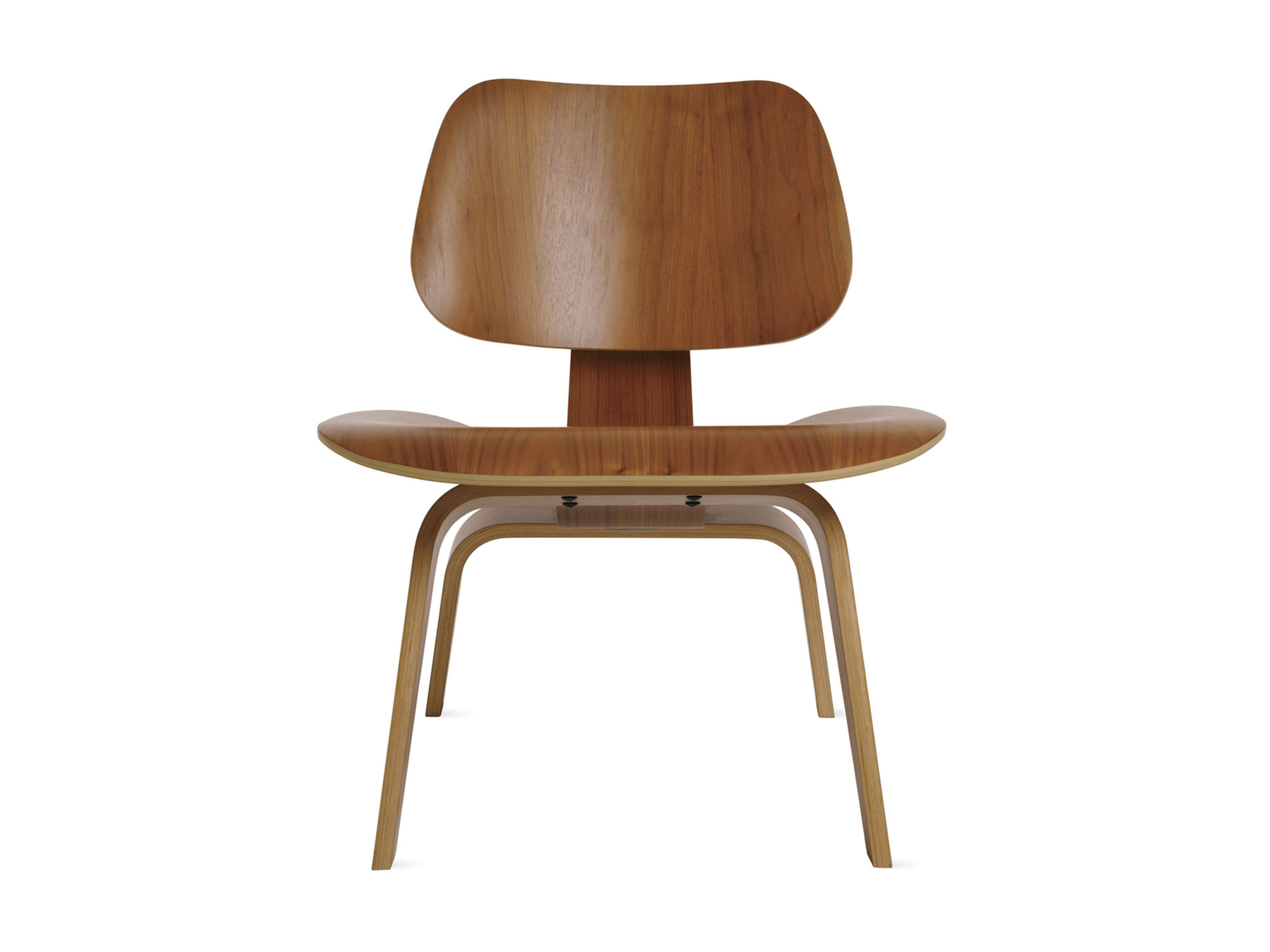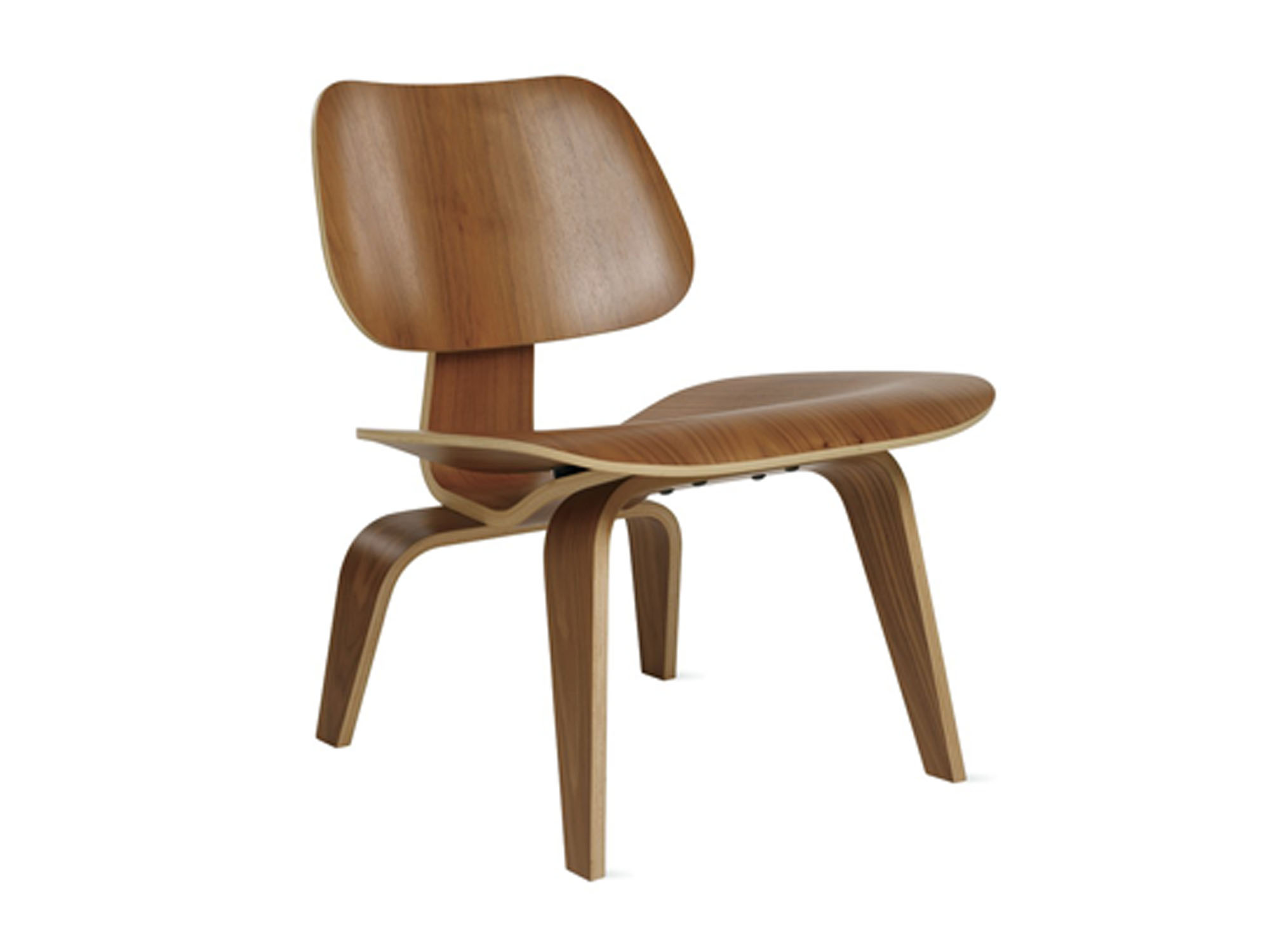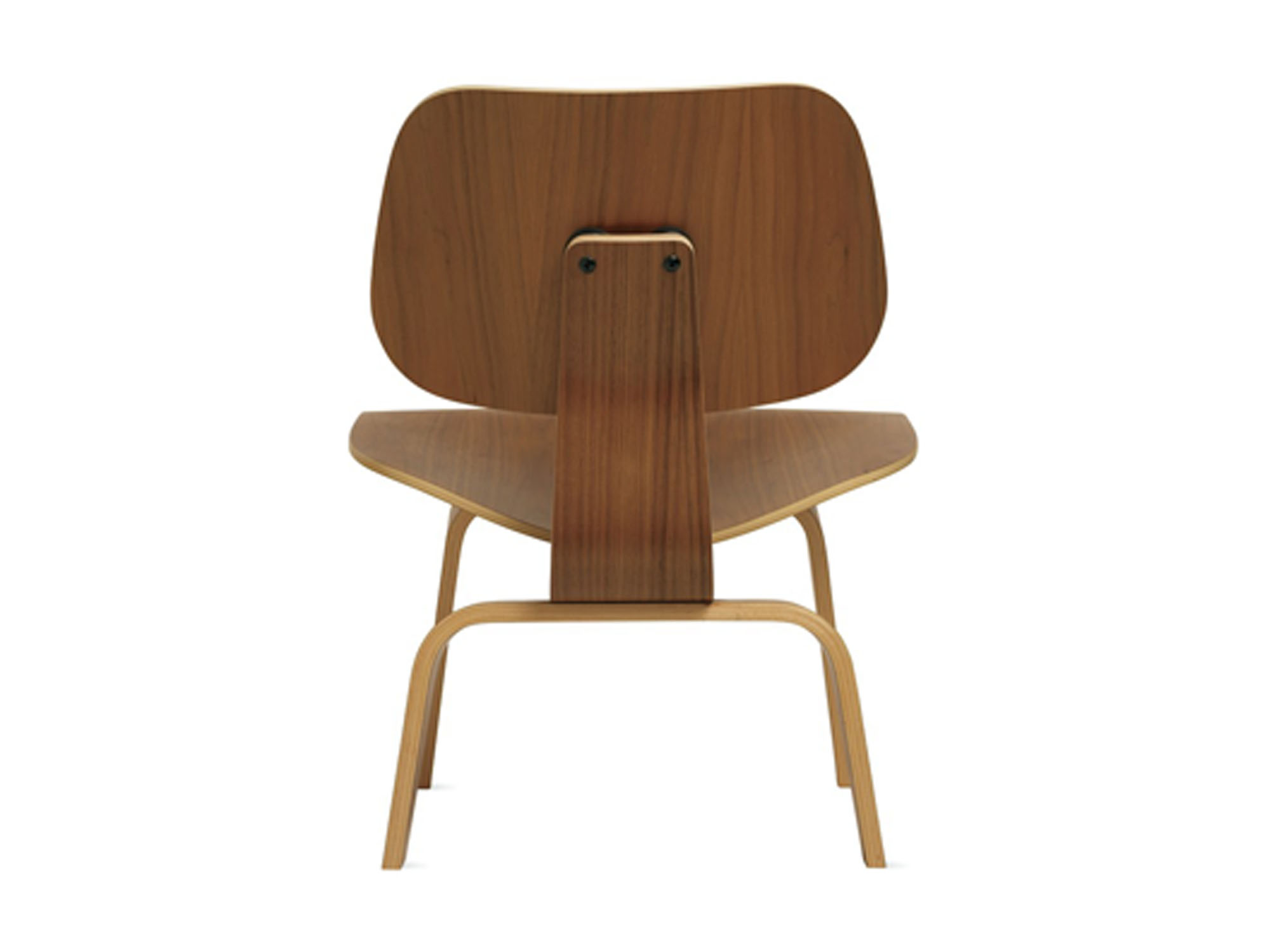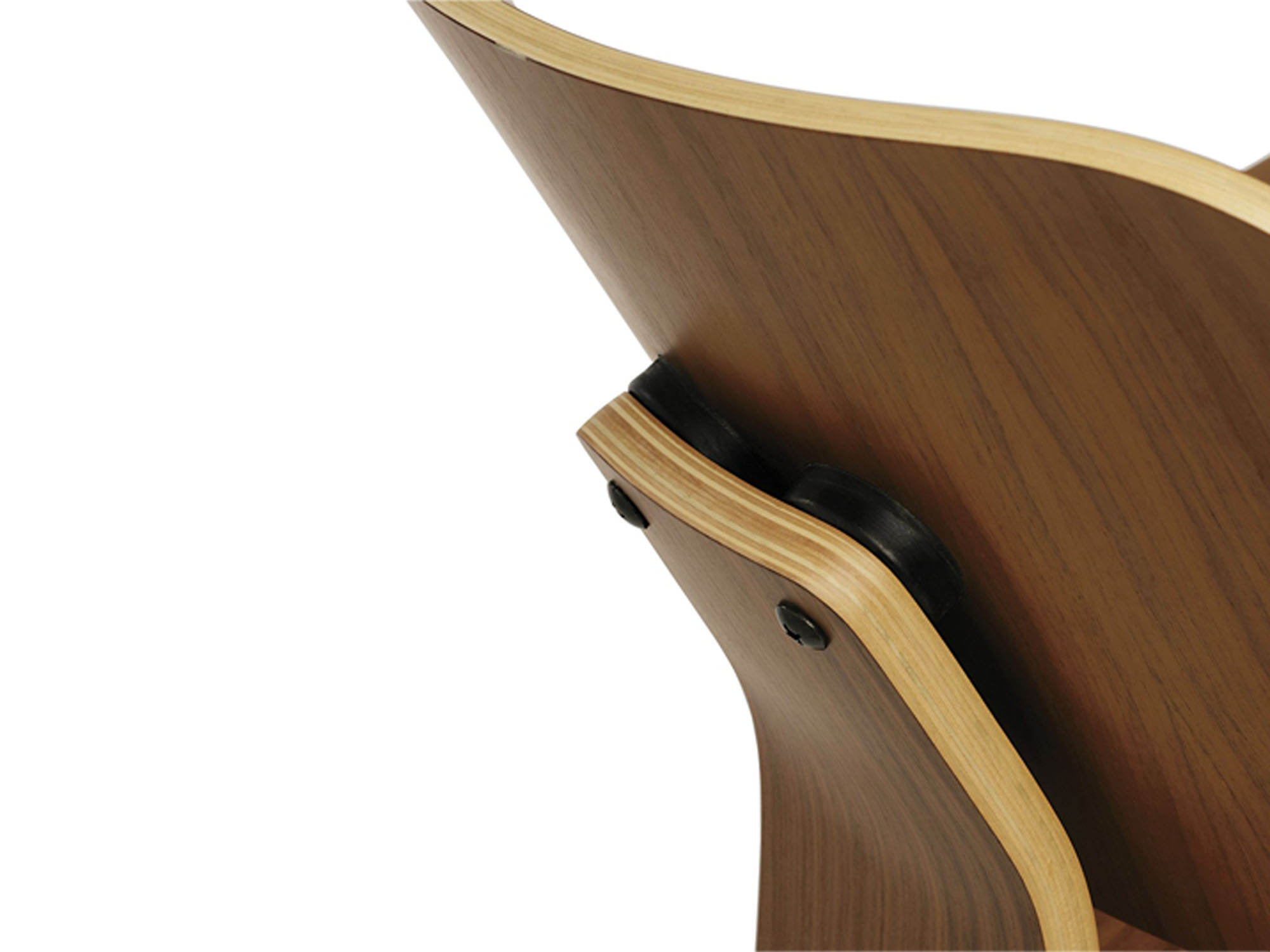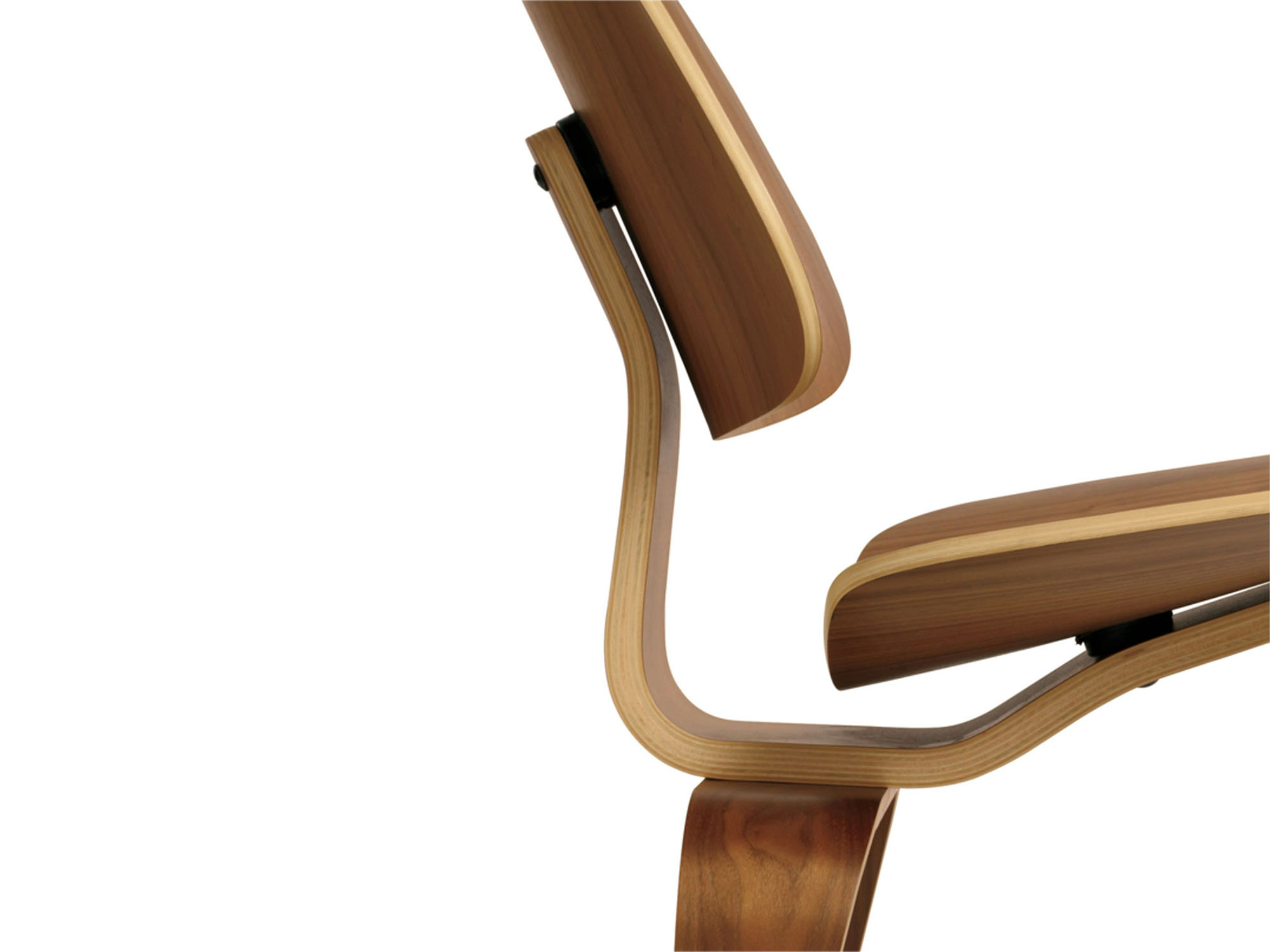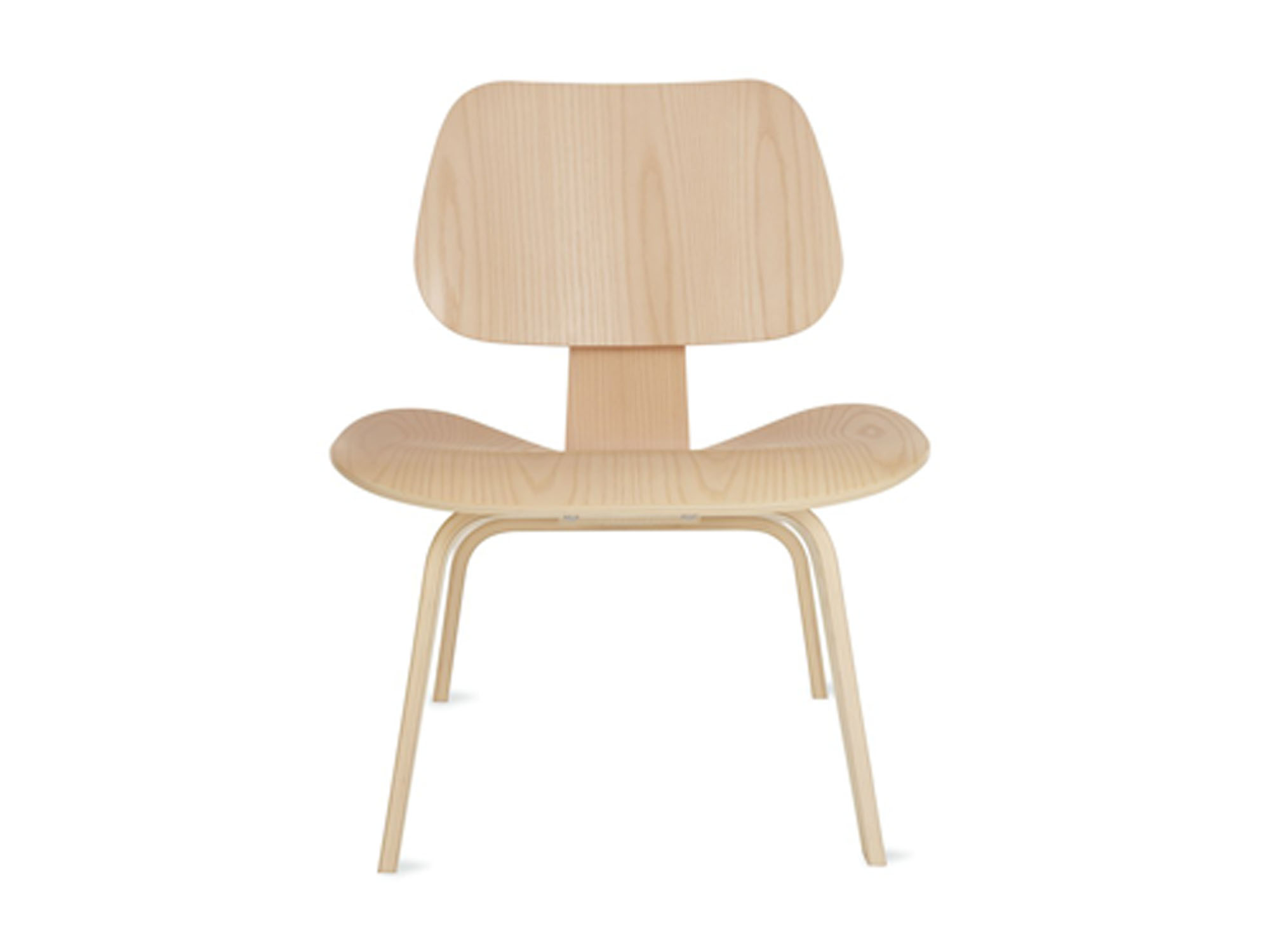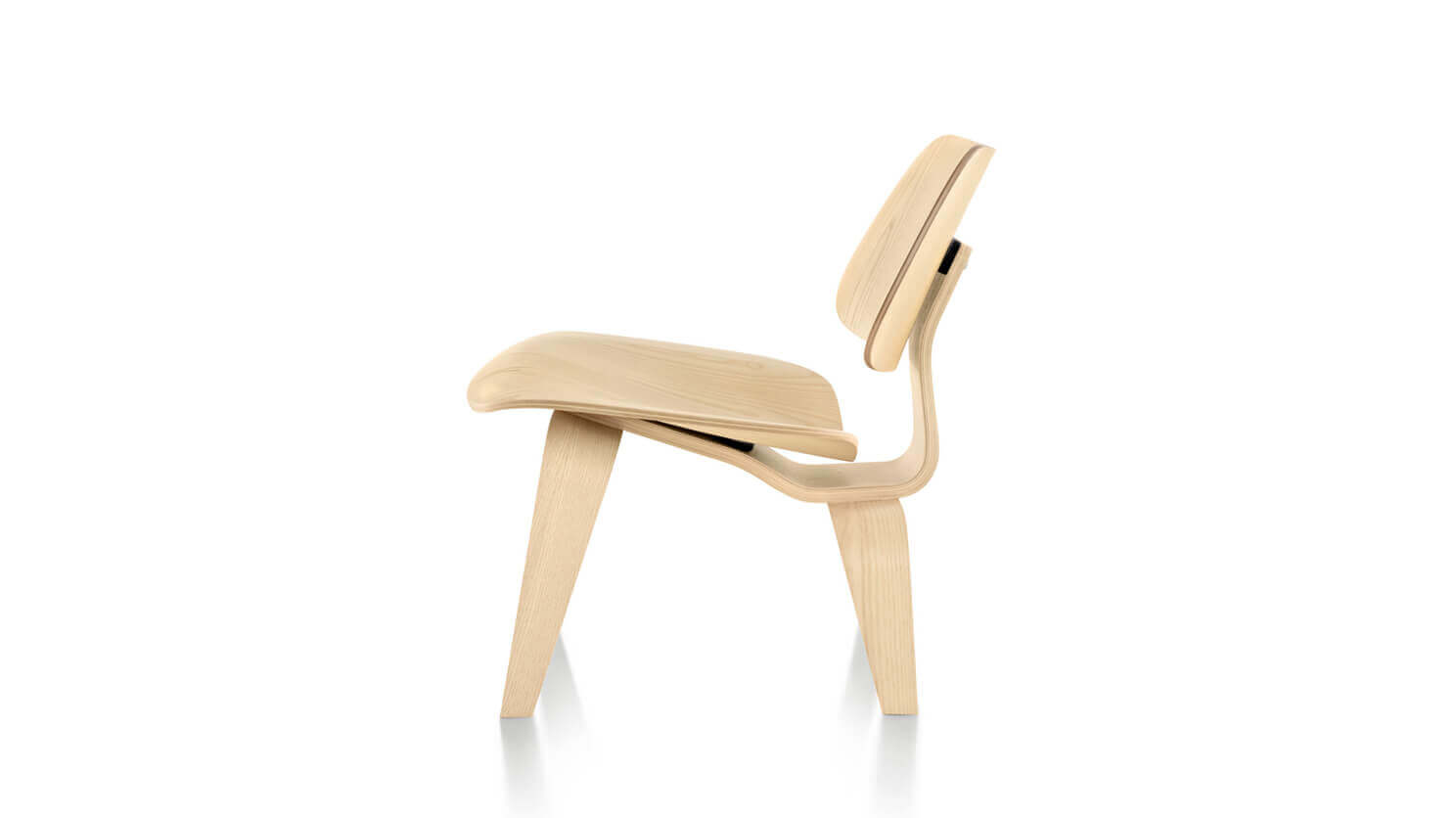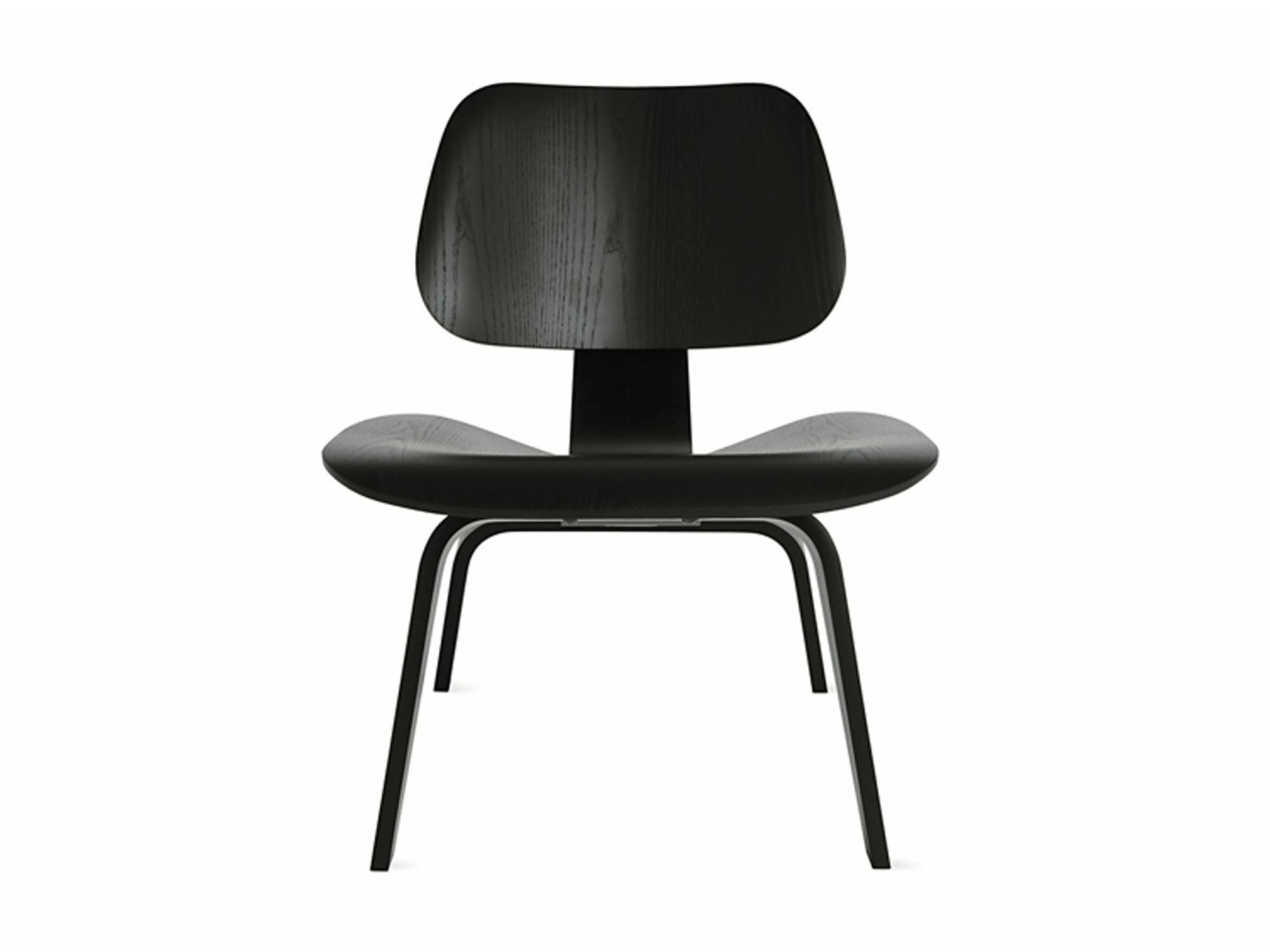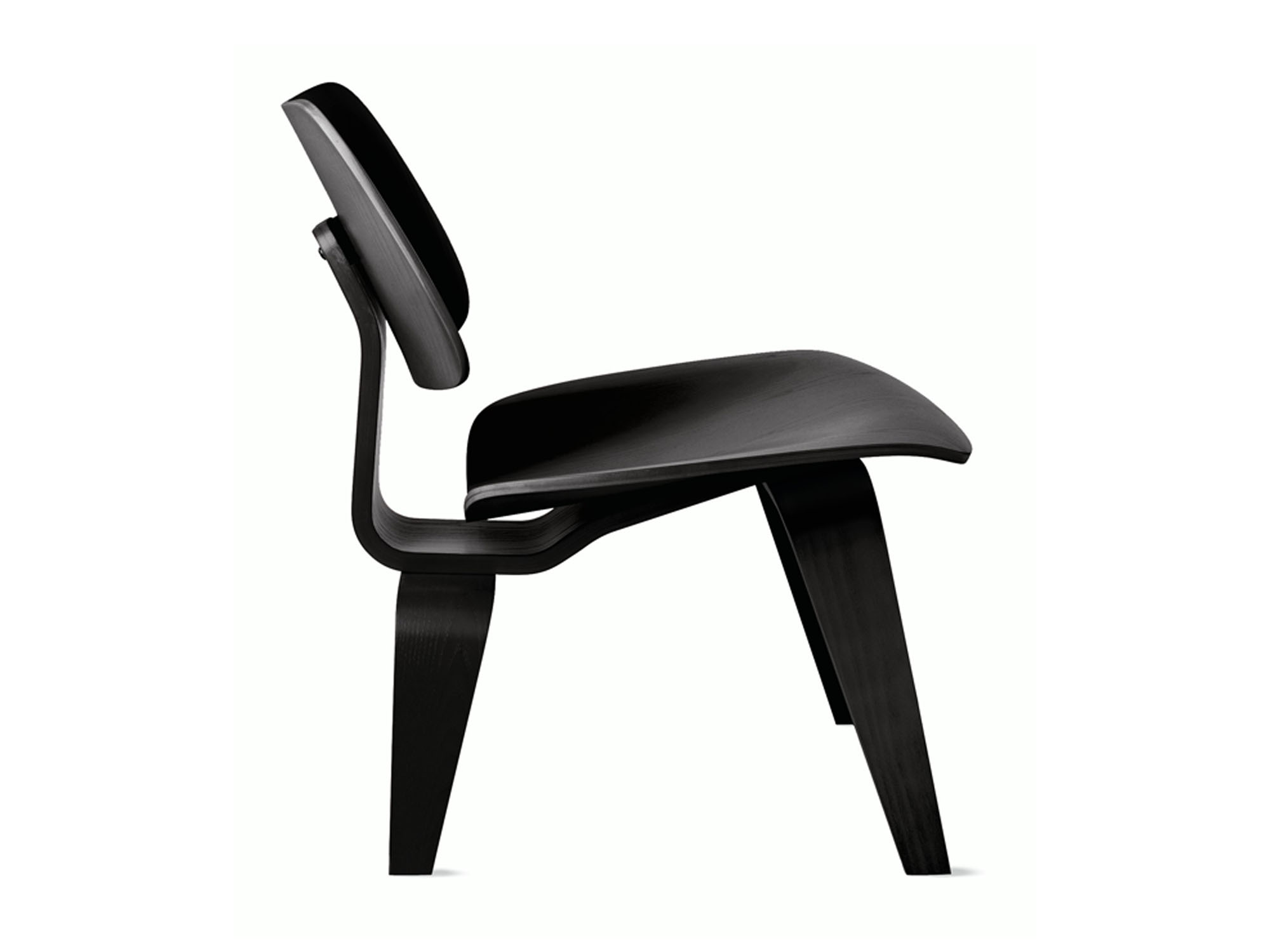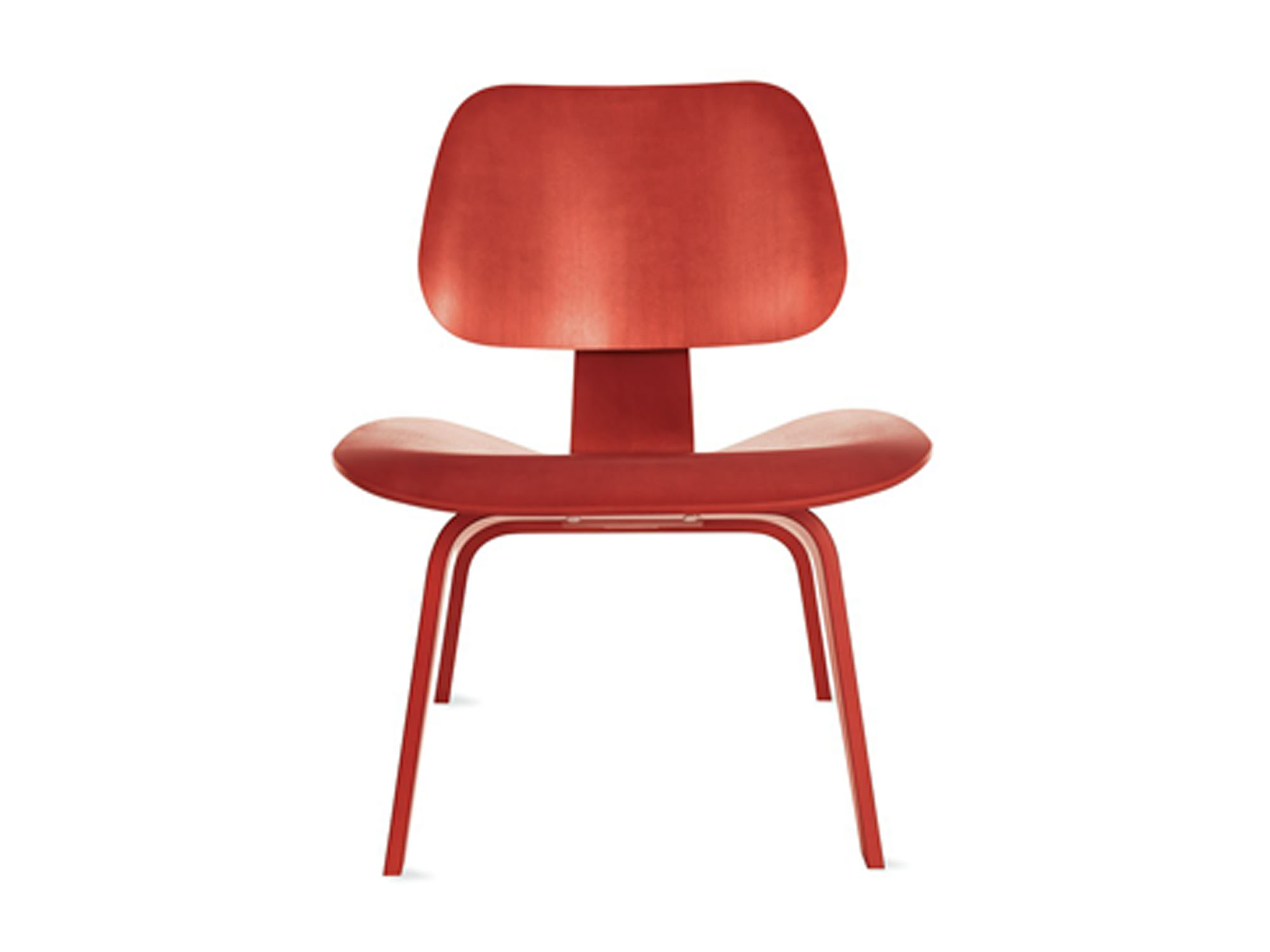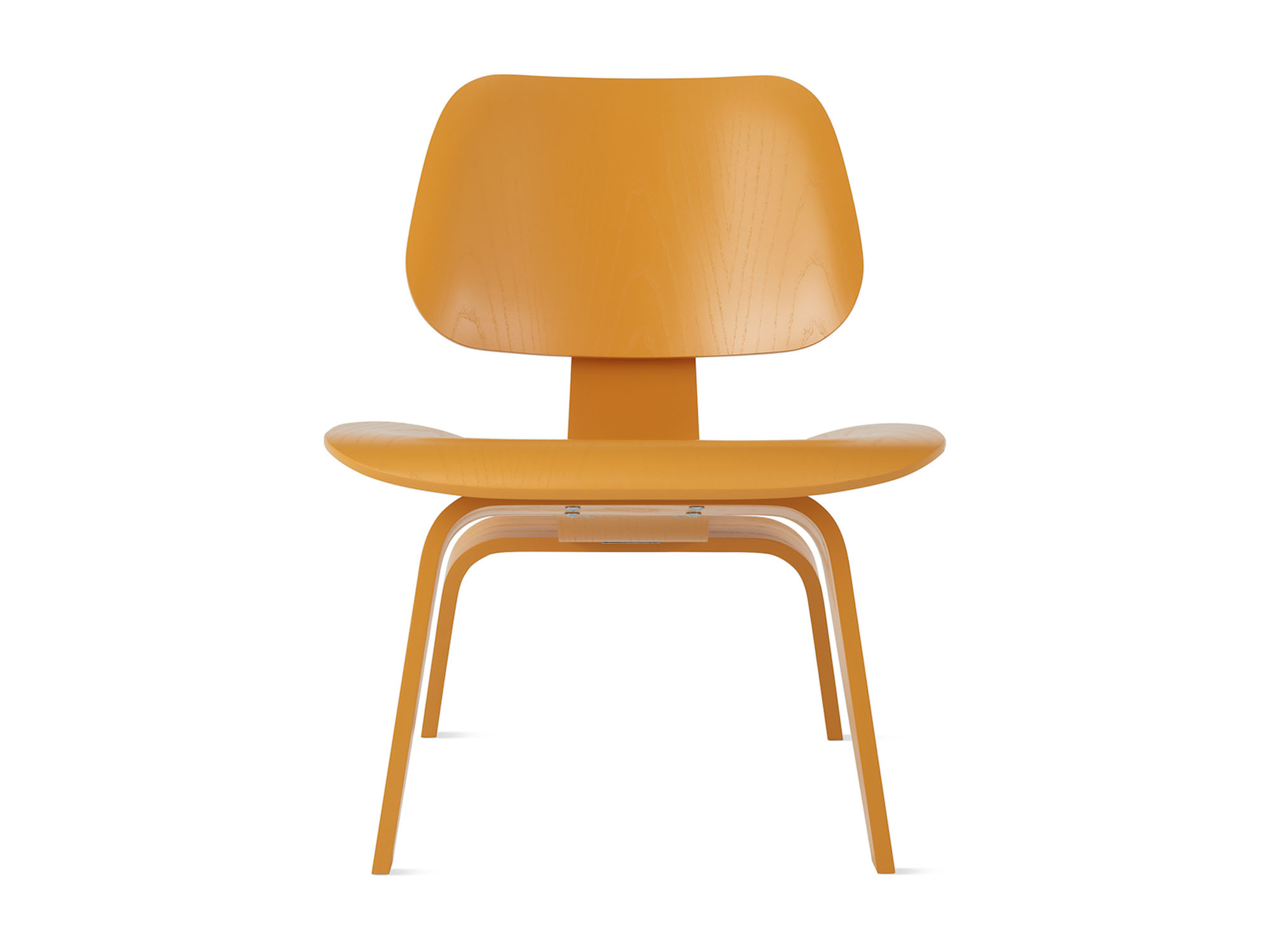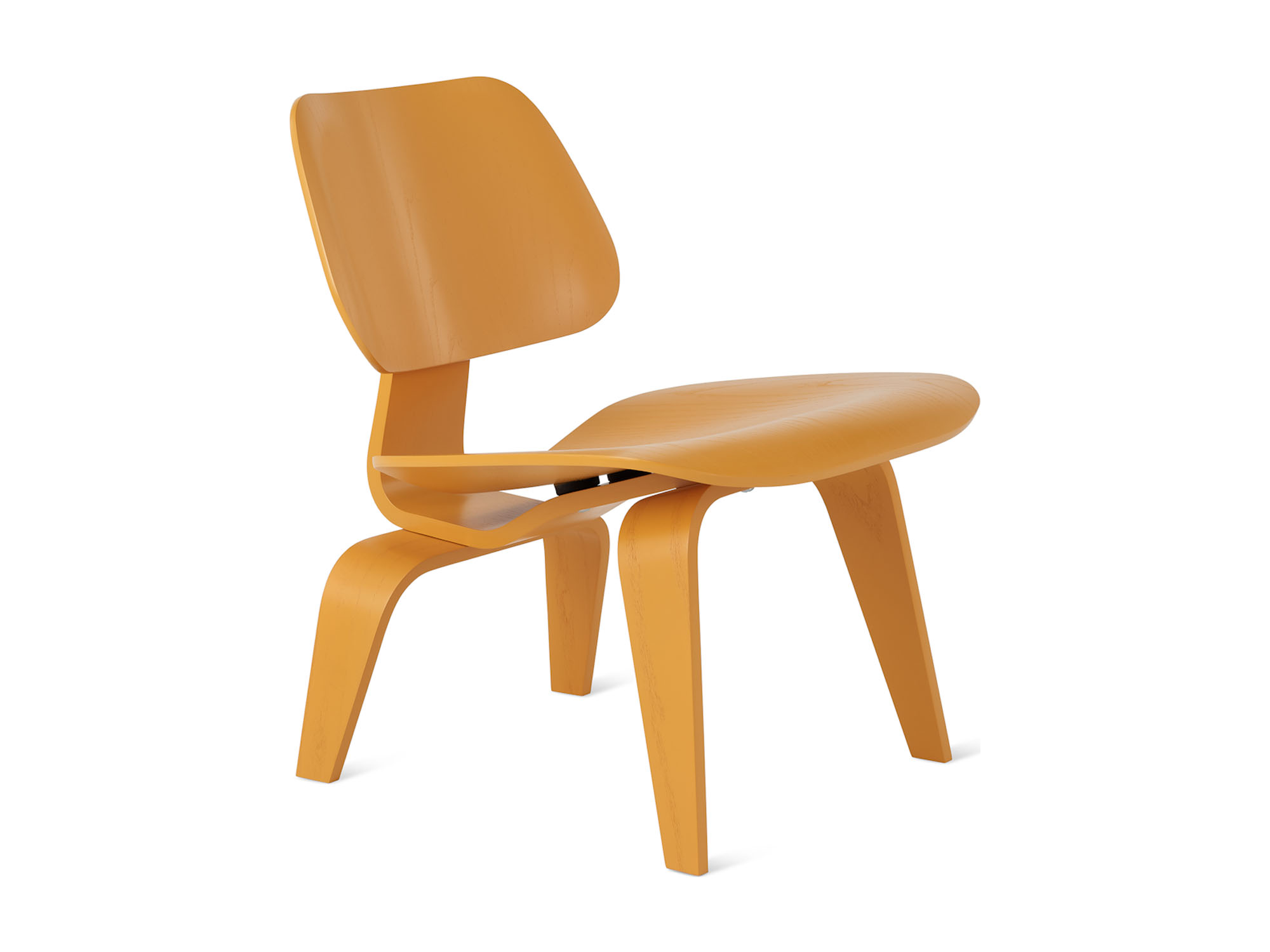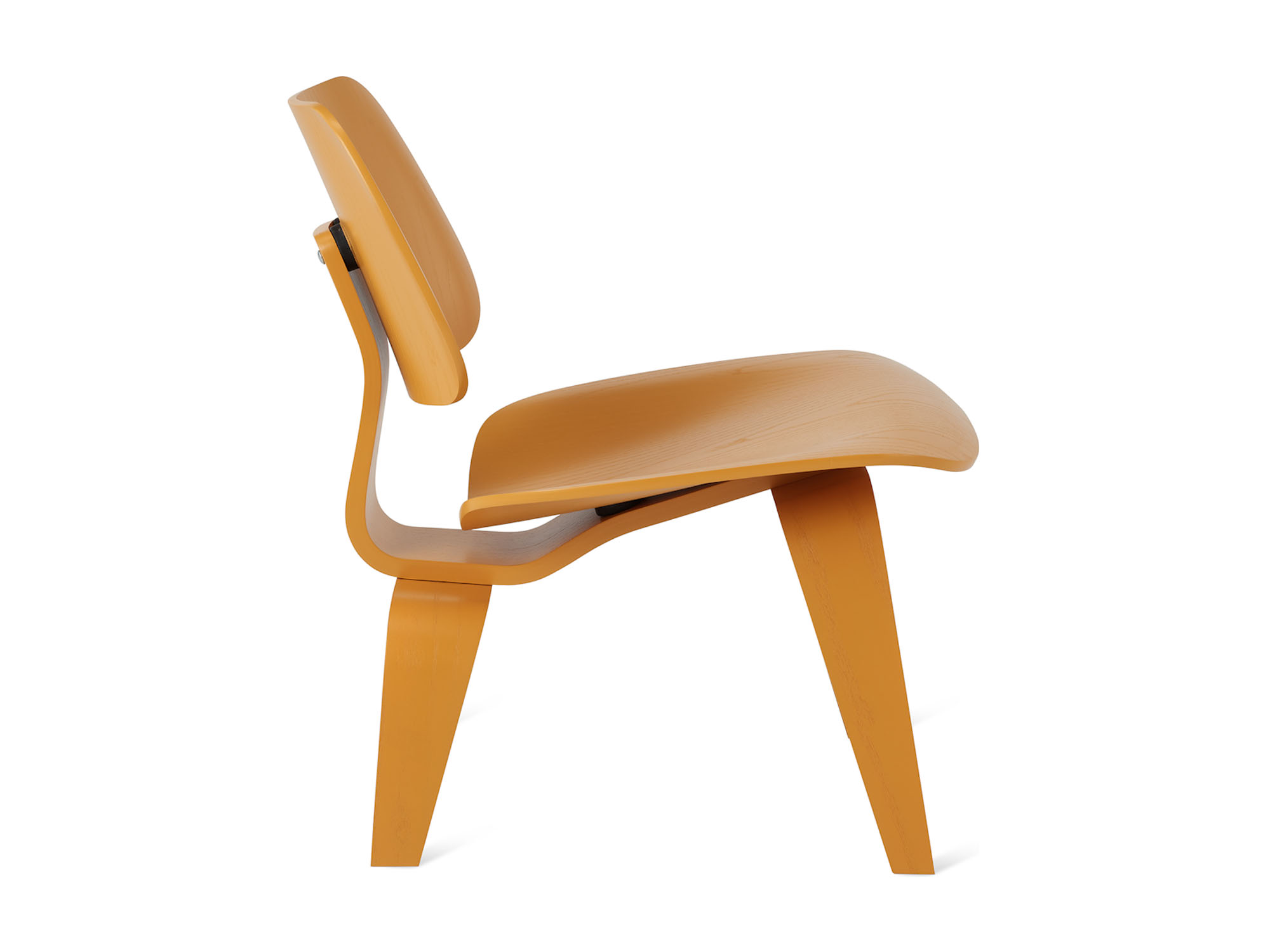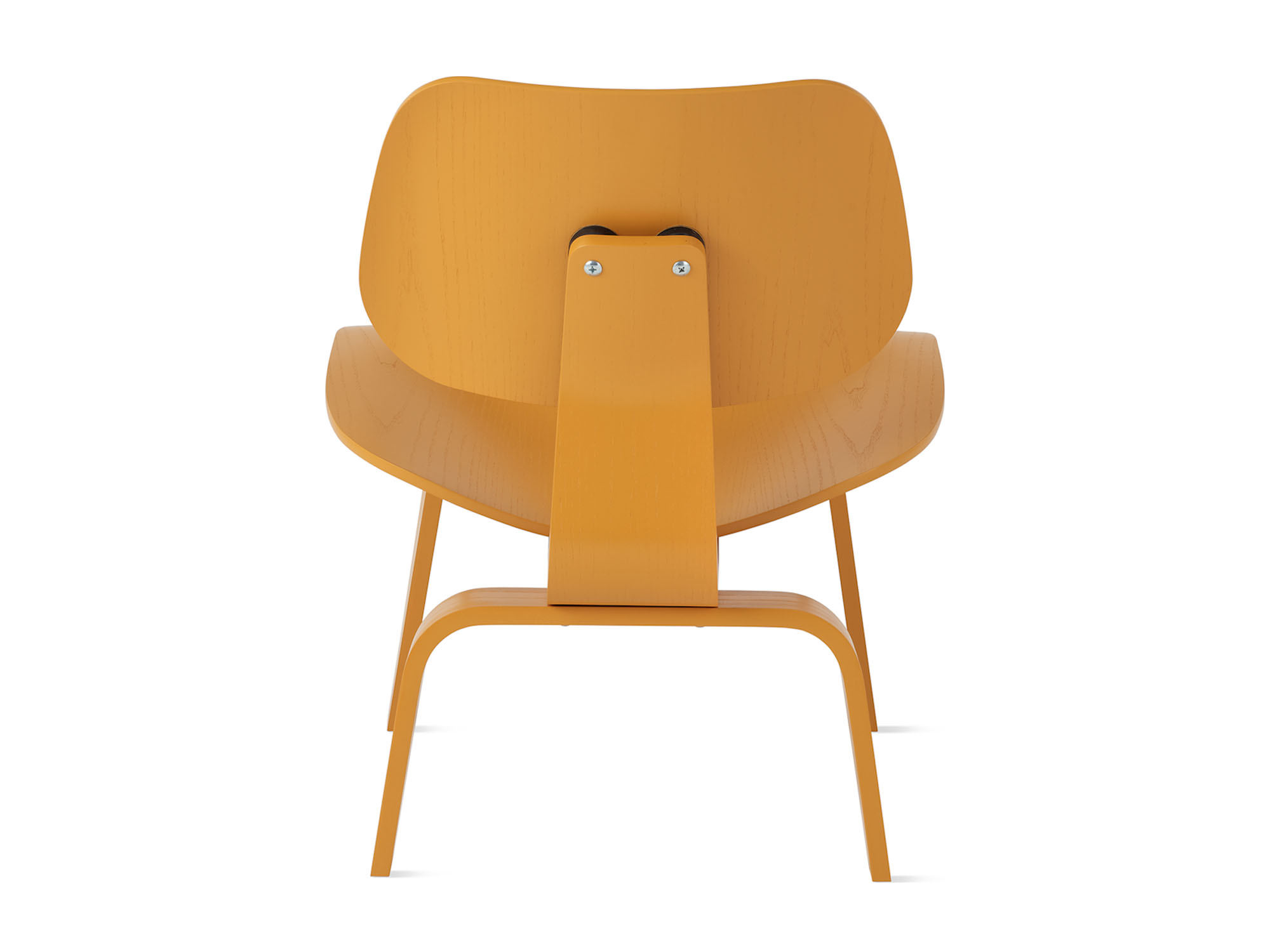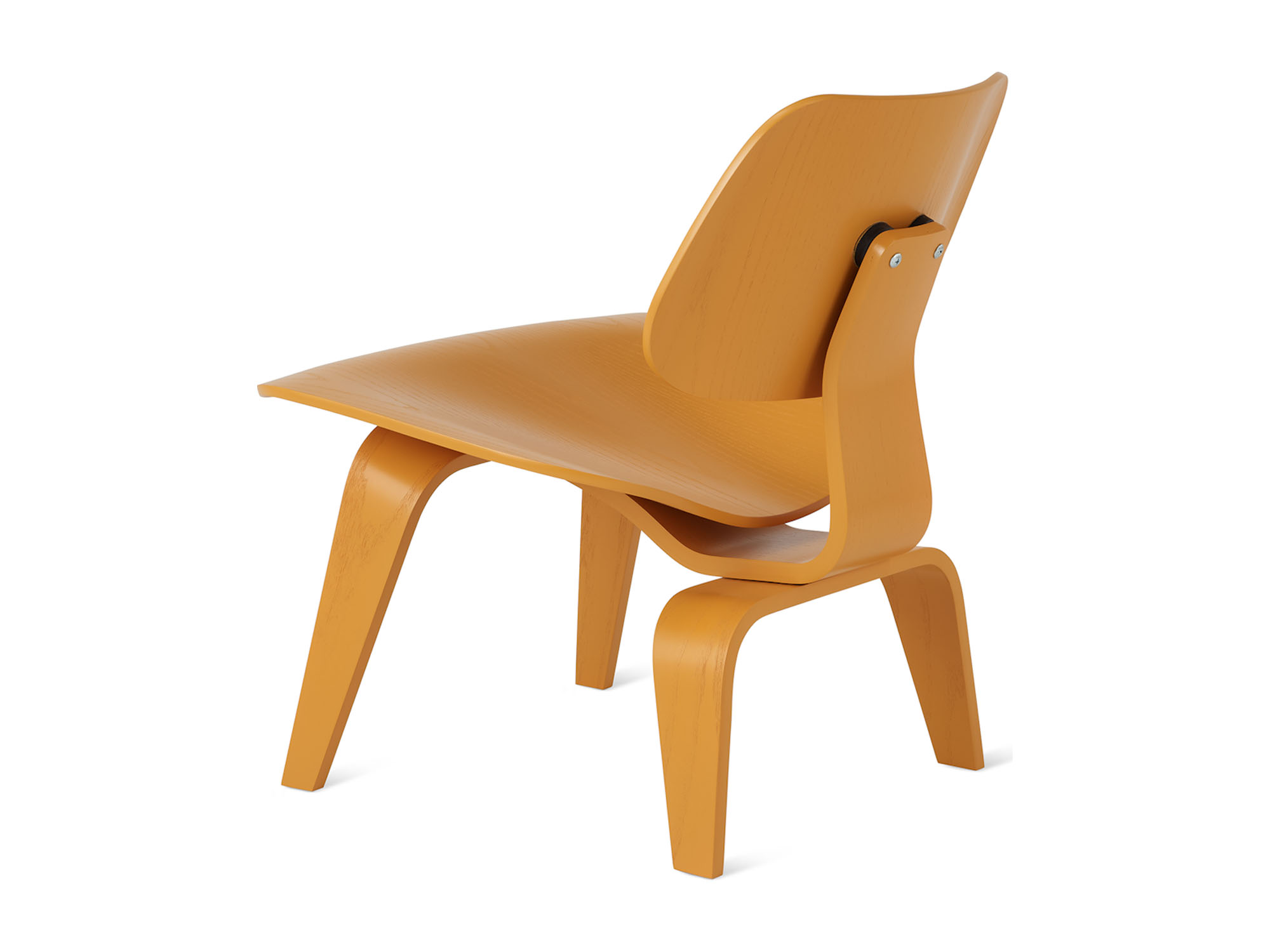Eames® Molded Plywood Lounge Chair
BY Herman Miller
$1,981.00
Measurements
Eames® Molded Plywood Lounge Chair
22″w × 24.2″d × 26.5″h
Shipping
Custom made Herman Miller items currently have an extended lead time and will be delivered by freight using Herman Miller’s logistical partner. Delivery timelines will vary depending on your location, however, please allow approximately 4-8 weeks for delivery.
Please note: White Ash has an extended delivery time of 18 to 22 weeks
Herman Millers’ delivery partner will contact you to set up an appointment to deliver your order within 24 to 48 hours of the product arriving at the local warehouse. All deliveries require an appointment and take place Monday to Friday between 8AM-5PM local time.
This is a threshold delivery – product will be placed just inside homeowner’s preferred entrance.
Warranty
Herman Miller offers a 5-year warranty that covers everything--including electrical components, casters, pneumatic cylinders, tilts, and all moving mechanisms. It also offers a 3-shift warranty that recognizes the changing nature of work and the need for products that can stand up to continuous use. Herman Miller labour-included warranty offers warranty work performed in Canada free of charge. View Herman Miller complete warranty.
Herman Miller Model #'s:
3350-320-4 LCW.EN
3350-320-11 LCW.11
3350-320-9 LCW.9N
3350-320-13 LCW.OU
3350-320-15 LCW.A2
Discover the Best Styles in Plywood Furniture for Modern Living
Seeking furniture that marries strength, fashionability, and cost-effectiveness? Furniture crafted from plywood stands out as a robust yet budget-friendly solution suited to contemporary lifestyles. The piece you are reading will enlighten you about its adaptability in design, affordability factors, and upkeep requirements. Explore the ways in which plywood can enhance your living area while maintaining high standards of quality without straining your finances.
Key Takeaways
Plywood furniture combines strength, durability, and a natural aesthetic, resulting from the material’s layered veneer construction which resists warping and cracking, making it ideal for both practical uses and artistic expression in modern design.
Iconic designs, such as those by Charles and Ray Eames, showcase the creative and innovative use of plywood in furniture, contributing to its prominence in modern architecture and design, proven by the longevity and iconic status of pieces like the Molded Plywood Lounge Chair (LCW).
Plywood’s sustainability is a key aspect of its desirability, supported by its production from renewable sources, energy-efficient manufacturing, minimal waste generation, strict emission standards, and certifications from initiatives like the Forest Stewardship Council (FSC).
The Art of Plywood: Elegance Meets Durability
Plywood stands out as a masterpiece of engineering due to its exceptional strength and pliability, which are ideal qualities for designing furniture. The distinctive composition of layers within plywood enhances its durability by providing resistance to warping and cracking, essential attributes in the creation of long-lasting furniture.
Plywood’s relatively light weight expands its versatility, making it an increasingly popular choice for various architectural and furniture projects thanks to this advantageous characteristic.
Crafting with Layers: The Plywood Process
The manufacture of plywood is a meticulous process which encompasses:
- The fusion of slender layers known as ‘plies’ or ‘laminations’ made from wood veneer.
- Altering the orientation of each consecutive ply by 90 degrees relative to its predecessor layer.
- This results in creating a material that’s both tough and adaptable.
- Plywood derives its unique durability and suppleness from this cross-grained configuration, compounded with the method employed to adhere these multiple layers of veneers.
When it comes to constructing premium furniture, various high-quality plywood veneers sourced from different species are preferred due to their beauty and functionality for such applications. With its even thickness and smoothness on surfaces, plywood streamlines both the construction and finishing stages for furniture makers, ensuring consistently attractive outcomes in finished pieces.
The Aesthetic Appeal of Plywood Furniture
Plywood provides more than mere robustness and longevity. It also embodies aesthetic appeal. Protective finishes like lacquer and varnish fulfill the practical role of making plywood water-resistant, while simultaneously accentuating its innate wooden texture. This embellishment narrows the visual disparity between ordinary plywood and opulent woods such as oak or walnut.
Wood oils, when used on interior plywood endeavors, penetrate the top layer of veneer. This not only elevates the inherent charm of the material, but also greatly enriches its authentic organic appearance within indoor settings.
Plywood in Modern Design: From Functional to Sculptural
The utility of plywood extends well beyond its practical applications. It is often selected by designers for both its structural qualities and the creative possibilities it offers, allowing for the formation of curved contours and complex shapes in cutting-edge furniture creations. Such innovative use is exemplified by masterpieces like Frank Gehry’s Bent Wood Collection and the Eames Molded Plywood Chairs, which stand as testaments to how plywood can marry functional necessity with artistic form through its sculptural robustness.
Designers such as Stefan Diez embrace plywood not merely as a material, but also as an artistic canvas, producing pieces that straddle functionality and visual artistry—from multi-dimensional wall installations to unique furnishings that reflect modernist principles centered around streamlined design, comfort-driven ergonomics, along with sustainable practices.
With a natural inclination towards strength paired with continuity in wood grain patterns—plywood enhances table designs combining aesthetic appeal with enduring structure. The iconic Eames Loungechair altered perceptions within furniture craftsmanship due to its moldable yet sturdy five ply seat construction. This was lightweight while maintaining minimalism visually without compromising on versatility or longevity. Contemporary visionaries like Ronan and Erwan Bouroullec continue probing into the capabilities of plywood ensuring it remains at the forefront throughout ongoing narratives in design innovation.
Iconic Plywood Pieces That Shaped Design History
The significance of plywood in the evolution of contemporary furniture and architectural styles cannot be overstated. The pioneering creations of Alvar Aalto, who crafted bent birch plywood furnishings in 1931, were a source of inspiration for Charles and Ray Eames’ revolutionary designs.
In current times, there has been a resurgence in popularity for mid-century modern and Art Deco themes, which has reestablished plywood as a prominent material. This comeback harmonizes the inviting feel of classic design with modern visual appeal.
Charles and Ray Eames: Masters of Plywood Molding
Ray Eames and Charles Eames were pioneers in the manipulation of molded plywood, propelling forward the use of this flexible material for furniture creation through their groundbreaking experiments before and throughout World War II. The duo honed their skills crafting MGM set pieces and fulfilling commissions from the US Navy during wartime, perfecting techniques they would later employ to design the renowned Charles Eames Molded Plywood Chairs. One iconic product of their ingenuity was dubbed ‘Best Design of the 20th Century’ by Time magazine—their lauded Eames Molded Plywood Dining Chair with a wood base.
The chairs produced by Herman Miller showcase an expertly constructed seat made out of molded plywood paired with buffers crafted from rubber shock mounts. These elements reflect a seamless blend of aesthetics and practicality. Moving on from early methods like using their homemade ‘Kazam! Machine advancements have been incorporated into producing each DCW chair—these refinements not only illustrate ongoing innovation within molded plywood furniture-making but also underscore why Herman Miller’s products stand at the forefront in terms of quality craftsmanship.
The Molded Plywood Lounge Chair Revolution
The Eames Molded Plywood Lounge Chair with a Wood Base, commonly referred to as the LCW, is celebrated for its unique and iconic design. Garnering an impressive 3.7 out of 5 customer rating demonstrates that it is well-received among consumers. The fact that most reviewers are likely to suggest this lounge chair to others highlights its esteemed reputation.
As a top-selling item in the furniture industry, the chair’s popularity underscores its important influence within both commercial markets and design communities.
Beyond Chairs: Plywood's Versatility in Furniture
The significance of plywood in crafting chair designs is undeniable, but its use extends across various kinds of furniture. In bedrooms, for instance, nightstands constructed from plywood demonstrate how the material can offer stylish and affordable solutions with sufficient space to organize personal belongings. The Arabesque table designed by Carlo Mollino stands as a testament to this adaptability—created from laminated maple plywood, it showcases complex yet airy construction that suits smaller living spaces well.
Employing 100% birch plywood in the manufacture of furniture pieces confers additional strength, allowing them to bear greater weight and prolonging their lifespan through extended usage.
How Plywood Enhances Contemporary Spaces
Plywood furniture is transforming contemporary design through its minimalist approach, emphasizing conscious living and sustainable practices. These pieces create purposeful spaces free from unnecessary clutter while offering durability that makes them suitable for use in both home and office settings.
The elegance of plywood can be seen in items like floating shelves, which boast a sleek look thanks to their concealed supports. This showcases the material’s ability to act as a refined component within modern interior designs.
Creating Cohesive Interiors with Plywood
Understanding the space and how furniture serves it is key to creating a uniform interior using plywood. To foster a harmonious rustic or coastal vibe, select weathered finish plywood furnishings, or pair them with complementary coastal decorative pieces. Such choices contribute to an integrated visual motif that not only elevates the room’s beauty but also its practicality.
Small Spaces and Plywood: A Perfect Match
The ingenuity of plywood furniture shines when contending with the constraints of confined spaces. To keep clutter at bay and optimize spatial utilization in small or multi-functional areas, opt for plywood pieces that incorporate storage solutions within their design. The predominant minimalist aesthetics and sleek contours characteristic of plywood furnishings play a key role in preserving an airy and orderly ambiance in compact living quarters.
Plywood-built fittings, custom-crafted to conform perfectly into distinctive nooks like those beneath staircases, offer functional storage options without overwhelming the room’s area—effectively enhancing the perception of expanded space.
Caring for Your Plywood Treasures
To keep your plywood furniture looking as good as new, a diligent approach to care and upkeep is crucial. The following suggestions will assist you in this endeavor:
- Frequent dusting of the plywood pieces with a dry microfiber cloth is advised to preserve their luster and fend off any lackluster appearance.
- Employ a gentle brush for removing accumulated grime, crumbs, and grease from the surfaces of your furniture to protect its coating and prevent cracking.
Shield your plywood furnishings from becoming lackluster due to excessive exposure by positioning them away from direct sunlight or using drapes for protection. It’s wise to ensure adequate airflow around these items, which contributes significantly not just toward extending their longevity, but also keeps them appearing fresh over time.
Protecting the Surface: Tips and Tricks
Ensure the protection of your plywood furniture’s surfaces by properly sealing them. This is particularly important in areas with high moisture, where waterproof phenol-formaldehyde resin adhesive or other protective substances such as latex-based paints, polyurethane-based paints, and epoxy sealants can be applied for safeguarding. Opting for pre-sealed and treated plywood may eliminate the need for individual waterproofing efforts while still providing an economical means to shield the material.
When dealing with outdoor plywood furniture, steer clear of water-based paint as a sealer because it lacks durability. This type requires more maintenance due to its susceptibility to ultraviolet light degradation and rainfall damage. Pay extra attention to sealing the edges of plywood since they tend to soak up moisture faster than flat surfaces do – this could lead to expansion and subsequent harm if left untreated. Properly waterproofed plywood helps prevent distortion from occurring, which otherwise happens when wood takes on water – maintaining both form and function over time.
Employing a finishing layer like varnish or polyurethane coating not only beautifies your piece but also acts as armor against scuffs and usage signs on your furniture made out of plywoods. For heightened longevity across numerous situations, including moist environments, you might want Bolster its endurance through chemical treatments designed to increase resilience against decay fungal growths well provide additional flame retardation properties.
Repairing Wear and Tear on Plywood Furniture
Even with the highest level of maintenance, it’s inevitable that plywood furniture will experience some degree of deterioration. To address small fractures or separations within the wood, substances like wood filler or epoxy resin are suitable for filling these imperfections. After these materials have set and dried completely, sanding should be performed to ensure a seamless surface is achieved. If the damage is severe, replacement of those sections becomes necessary by excising the compromised portion and affixing a new segment of plywood cut to exact specifications.
For areas where strength has been compromised in plywood furniture, applying fiberglass cloth combined with epoxy resin serves as an effective reinforcement strategy. This method ensures robustness upon completion of the curing process for long-term fortification against wear and tear.
Sustainability and Plywood Furniture Manufacturing
Furniture made from plywood doesn’t just offer design and practicality. It is also a choice grounded in environmental consciousness. Plywood comes from a sustainable material—wood—that, through mindful forest management, supports the preservation of forests. The manufacturing process for plywood consumes considerably less energy when compared to other construction materials, which translates into lower emissions of greenhouse gases and diminishes its carbon footprint significantly.
Making the most out of wood resources is another advantage offered by plywood as it allows for nearly complete utilization of a tree log with minimal wastage involved. This efficiency plays an essential role in reducing the amount of wood debris that contributes to landfill accumulation and environmental degradation. Production standards for commercial plywood products are stringent regarding emission control—they demand low volatile organic compound levels ensuring better air quality indoors while simultaneously curbing air pollution outdoors.
The Eco-Friendly Nature of Plywood
Exploring plywood’s environmentally friendly characteristics, we can see that it utilizes trees more efficiently than solid wood. This is because plywood consists of thin layers taken from a tree in the form of wood veneer, enhancing the usage obtained from each tree. The process of making furniture out of sustainable plywood incorporates techniques that save resources and minimize environmental impact throughout its life cycle—from extraction to disposal. As a result, manufacturing this material yields less waste when compared with crafting items solely from solid wood as these veneers are bonded together.
In terms of responsible forestry practices for harvesting materials required for creating plywood, international guidelines like those set by the Forest Stewardship Council (FSC) are followed to manage forest resources sustainably. Plywood stands out not only for being naturally degradable, but also because it breaks down without adversely affecting our planet’s ecosystems.
Certifications and Standards for Green Furniture
When choosing plywood furniture, certifications and standards for green furniture serve as a confirmation of its eco-friendly nature. The Forest Stewardship Council® (FSC) stands at the forefront of forest certification schemes, ensuring that wood comes from well-managed forests. Products made from FSC-certified wood are recognized in green building practices and have gained support through endorsements by LEED®. Rating System administered by the US Green Building Council as well as being embraced by the Living Building Challenge put forward by the International Living Future Institute.
Employing plywood with FSC accreditation means you are directly supporting forestry operations that prioritize sustainability, which translates into sustainable design elements within your chosen pieces of furniture or cabinetry. This category encompasses a spectrum of environmentally sound materials including decorative veneers holding an FSC stamp, suitable to be attached to certified veneer cores or onto pMDI-bonded MDF bases for projects committed to ecological integrity.
Customizing Your Plywood Pieces
Personalized plywood furniture offers homeowners the opportunity to add a distinctive flair that marries artistry, traditional craftsmanship, and cutting-edge technology. During the design stage of custom-made plywood furnishings, clients work closely with designers to brainstorm and draft ideas that eventually become elaborate plans or three-dimensional representations. These are tailored according to individual taste, spatial requirements in their homes, and financial constraints.
The production process for tailor-made plywood furniture consists of various phases:
- Slicing
- Smoothing
- Molding
- Assembling
- Enhancing
Throughout these stages, there’s a blend of time-honored skillfulness and advanced machinery employed—including CNC technologies as well as machine-pressed thin sheets—to ensure products meet high standards comparable even to precise items like bicycle pumps.
Bespoke Designs: Tailoring to Your Taste
Custom-made plywood furniture is designed to match the unique style preferences of each customer, ensuring that every item is both functional and an expression of their individual design tastes. The partnership between designer and client plays a pivotal role in custom furniture creation, allowing for precise alignment with the person’s fashion sense and spatial requirements.
Plywood offers robustness and manageability making it an ideal choice for do-it-yourself (DIY) furnishings that enhance personal interior styles. This material provides a budget-friendly solution for those seeking sophisticated designs, delivering opulent visual appeal without solid wood’s associated costs.
Unique Finishes and Upholstery Options
Plywood serves as a versatile base for various finishes, ranging from veneer applications that accentuate the organic beauty of wood grain to bold laminates or customized paintwork. Plywood furniture can gain an elegant, timeworn charm through a black wash finish which keeps the natural texture of the grain visible.
The enhancement of plywood furnishings with custom upholstery presents numerous options like plush wool fabrications, choice cushioning fills and distinct hand-tufted details. These are ornamented by bespoke touches such as nailhead accents or mixed-fabric designs tailored to individual tastes. To elevate the sophistication and comfort levels of plywood pieces even more, consider precision-made slipcovers, specialized cushions featuring exclusive trimmings and skirt detailing for sleek style enhancements. For those seeking added uniqueness in their space, they should explore upholstered versions crafted to fit personal preferences.
When choosing fabric for upholstery work on furniture items:
- Consider long-term endurance
- Opt for colors that complement your decor including brick color selections
- Select patterns mindfully
- Pay attention to textural quality
These factors directly affect how well furniture withstands time’s test while seamlessly blending into your interior aesthetic. The interplay between different materials can offer a stunning balance when it is manifested in chairs constructed from plywood incorporating robust steel frames alongside foam wrapped in cozy upholstered textiles—marrying resilience with sumptuous softness.
An array of materials married with plywood not only enhances its functionality, but brings forth visual allure accompanied by tactile richness—for instance, viscose fabrics paired with foundational plywood elements infuse furnishings with refined elegance.
Integrating Plywood Furniture into Your Home
Incorporating plywood furniture into your interior design is more than just finding room for a new piece. It’s about ensuring the furnishings serve their intended purpose and enhance the functionality of each space. It’s critical to select plywood pieces proportionate to the size of your rooms, which helps preserve a spacious and orderly environment. Strategically placing bold plywood items in highly visible locations such as living areas or foyers can spotlight their craftsmanship while they remain practical.
For compact or versatile environments, opt for multifunctional plywood furnishings that incorporate storage options—this aids in reducing messes while optimizing available space. When weaving plywood elements with existing decor themes, consider aligning them with your current color scheme for seamless integration into your home’s aesthetic ambiance. Achieve visual continuity by selecting styles of plywood furniture that complement either similar historical periods or designs within your collection, creating an effortlessly blended atmosphere throughout your residence.
The Perfect Little Area: Nook Setting Ideas
Utilizing plywood furniture to design a snug nook can convert an unused corner into the most beloved space within your home. Custom plywood shelving offers individualized storage options that enhance a room’s overall aesthetic, perfectly suited for crafting a personal nook setting.
Introducing a corner cabinet crafted from plywood creates the foundation of an inviting nook where comfort meets utility through ample storage. Incorporating seating with built-in storage, like a stylishly designed plywood bench, provides dual functionality as both seat and organizer in spaces destined for reading or enjoying breakfast. A compact dining set made from plywood is particularly effective at transforming tight corners into warm and efficient spots ideal for morning meals—an epitome of maximizing small living spaces.
A well-crafted plywood bench featuring integrated storage merges neatly with dining areas short on square footage by serving double duty as furnishings essential in restricted quarters. Employing plywood also allows one to fashion an eye-catching accent wall which brings distinction and flair—a perfect complement behind any strikingly defined nook within the interior space’s decor.
Built-In Bookshelves and Storage Solutions
Effortlessly optimize space and keep your home organized with custom-made built-in bookshelves and storage systems constructed from plywood. The adaptable nature of plywood enables the crafting of tailor-made bookshelves that improve organization while maximizing space within a residence.
Constructed using Baltic birch plywood, stackable shelves showcase the beauty and strength of this material, offering modular storage solutions as well as workspaces. Demonstrating the versatility of plywood in bedroom furnishings, a minimalist shelf headboard serves a dual purpose by melding together the functionality of both a headboard and sensible storage options.
Achieving Balance with Mixed Materials
In the realm of furniture design, achieving a balanced and aesthetically pleasing composition often involves mixing various materials. Utilizing an assortment such as plywood in conjunction with other elements not only boosts the aesthetic charm but also fulfills practical needs like enhanced strength and comfort levels. Introducing plush textures, for instance wool or leather, to items crafted from plywood can strike a delightful contrast that couples coziness with streamlined style, delivering furnishings that are both inviting and chic.
To improve both the structural resilience and visual appeal of furniture pieces, these materials may be coupled with plywood.
- Metals
- Stones
- Glass
- Fabrics
Such integrations pave the way for crafting unified furniture pieces that radiate appeal and adapt seamlessly across diverse interior styles ranging from classic elegance to modern simplicity.
Combining Wood and Metal for Industrial Chic
The hallmark of industrial chic style lies in the harmonious blend of wood and metal within its furniture pieces. This design approach melds plywood with robust metals such as steel, creating furnishings that are aesthetically striking and reliable. The juxtaposition of cool, rigid metal against warm, organic wood offers a balanced visual appeal suitable for trendy city lofts, cutting-edge homes, and modern workspace environments.
One chair embodies this industrial chic essence perfectly by integrating the organic feel of eight ply legs made from plywood with the resilience and streamlined look of a metallic base. Mid-century modern inspiration is evident in birch plywood coffee tables set on slender hairpin legs—this showcases the signature layered edges characteristic to plywood designs. The Walnut Beveled Profile ‘Hudson’ Dining. Table marries an elegant steel frame with a rich walnut-toned plywood surface to create an inviting yet sophisticated piece perfect for contemporary dining settings.
Soft Textures and Plywood: A Harmonious Contrast
The juxtaposition of contrasting elements is key in interior design, especially when combining the tactile warmth of soft fabrics with the structured appeal of plywood furnishings. A case in point is the Madison Plywood modern chair, which offers both comfort and style by merging an upholstered seat and backrest with a sturdy plywood foundation. This fusion ensures users enjoy coziness without compromising on the inviting appearance provided by plywood.
Pairing delicate textures alongside firm materials such as plywood and rustic Sacramento brick brings about a balanced contrast while elevating sophistication within a space. The strategic incorporation of thin sheets in this mix plays up aesthetic charm even contributing to an engaging visual dynamic within any room’s decor.
Summary
During our investigation into plywood furniture, we have uncovered the substantial durability, adaptability, and visual charm that plywood provides. The revolutionary impact of plywood on contemporary furniture design has become evident through the celebrated works of Charles and Ray Eames as well as in practical and fashionable solutions suitable for compact living spaces and storage necessities. We have also gained insight into how to maintain and preserve our valued pieces made from this material to extend their lifespan. Thanks to its environmentally friendly qualities paired with boundless personalization possibilities, plywood stands out as an ideal fusion of elegance, practicality, and environmental responsibility. Thus when contemplating enhancements to your furnishings remember the enchanting properties of plywood which can elevate your environment into a chic yet cozy eco-friendly sanctuary.
Frequently Asked Questions
Why did Eames use plywood?
Eames used plywood due to a shortage of metal during the war, leading to the production of fuselage panels for a military glider made out of plywood. This was a practical solution during a time of material scarcity.
How durable is plywood furniture?
Furniture crafted from plywood offers longevity because it is constructed with several wood layers that are bonded together. This design ensures robustness and safeguards against any bending or splitting, thus making it ideal for regular usage.
Which plywood is best for home furniture?
Opting for A-Grade plywood is the superior choice for home furniture because of its high-quality construction and minimal imperfections.
While B-grade plywood can be considered as well, it tends to have a higher number of repaired flaws.
Can I make furniture out of plywood?
Indeed, plywood is an excellent selection for constructing furniture thanks to its robustness, enduring nature, and straightforward handling.
How is plywood crafted?
Thin sheets of wood veneer, often referred to as ‘plies’ or ‘laminations,’ are bonded together with their grain patterns alternated at right angles to form plywood. This process creates a durable and pliable material consisting of multiple layers of wood.
The Eames Molded Plywood Lounge Chair, offered through renowned retailers such as EQ3 and Herman Miller in Canada (HM Eames), stands as a monument to mid-century modern design. This iconic piece, celebrated for its ergonomic form that cradles the body, combines both elegance and comfort. Crafted with the innovative technique of molding plywood, the chair showcases the creative genius of its designers, making it a sought-after addition to any home or office space looking for a touch of timeless style.
The Vintage Eames Lounge Chair, an icon of mid-century modern design, showcases the innovative use of molded plywood technology perfected by Charles and Ray Eames. This chair not only exemplifies style and comfort but also represents a significant advancement in furniture design, blending form and function seamlessly.
Find additional chair designs here, or discover Herman Miller office designs or EQ3 outdoor furniture designs.
